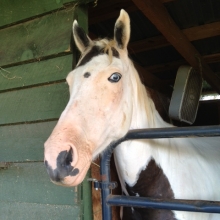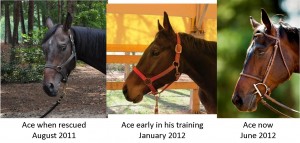Study Stall: Fall Vaccinations for Horses
It’s that time of year again! School is back in session and, for many of us, that means it’s time for the yearly fall vaccinations for our horses. It is also a good time to schedule an appointment with your veterinarian for a wellness exam.
Wellness Exam
A wellness exam is a full physical examination, where a veterinarian examines your horse’s breathing, lungs, heart, nose, eyes, ears, stomach, legs, feet, and overall general appearance. You can also discuss your feeding and deworming schedule with your vet at this time.
Key vaccines for adult horses in the piedmont area of North Carolina, and according to the AAEP guidelines, include the 4-in-1(Eastern/Western Equine Encephalitis, Tetanus, Equine Influenza, Rhinopneumonitis (EHV-1 and EHV-4)), West Nile, and Rabies Vaccines.
Equine Encephalomyelitis, both Eastern and Western, is referred to as a “sleeping sickness” and as of late August, 8 cases have been diagnosed in NC i. It is usually transmitted when an infected bird or rodent is bitten by a mosquito and then subsequently the mosquito bites a horse or a human. Symptoms vary widely but are all neurologic in origin. Staggering, paralysis, lethargy, drooling, and loss of appetite are just a few main clinical signs that are the most commonly seen.
Tetanus is an anaerobic bacterium known as Clostridium tetani; it is not a contagious disease but it is often a fatal disease. Infection is often through a deep puncture wound of the foot. Clinical signs include third eyelid protrusion, spastic paralysis (sawhorse stance), lockjaw, and sensitivity to light and sound.
Equine Influenza is one of the most common and contagious respiratory diseases. It is transmitted through the air in the form of a snort or cough, but is not often fatal. The oldest and youngest horses will be most affected. Clinical signs include a cough, nasal congestion and discharge, lethargy, loss of appetite, and a fever.
Rhinopneumonitis is inflammation of the lungs and nose caused by an equine herpes virus. Outbreaks will most commonly occur when the horse is stressed or his immune system is low. Signs of an outbreak can vary from being unsound, pneumonia, bloody nose, or cough.
West Nile Encephalitis is inflammation of the brain and nervous system caused by the West Nile Virus. An infected bird is bitten by a mosquito and the mosquito then transmits the virus to humans or horses. Signs include any neurologic abnormality, such as stumbling, lethargy, fever, paralysis, head pressing, seizures, and circling.
Rabies is transmitted through the saliva of an affected animal. The most reliable signs include any change in behavior, anorexia, nervousness, irritability, excitability, aggressiveness, and paralysis. If a rabid animal is seen around your horses, please contact animal control.
♥♥♥♥♥♥♥♥♥♥♥♥♥♥♥♥♥♥♥♥♥♥♥♥♥♥♥♥♥♥♥♥♥♥♥♥♥♥♥♥♥♥♥♥♥♥♥♥♥♥♥♥♥♥♥♥♥♥♥♥♥♥♥♥♥♥♥♥♥♥♥♥♥♥♥♥♥♥♥♥
Study Stall: Myth or Legend?

At first site, the unusual markings on this mare’s face and body certainly give pause. Odd looking, indeed, but gaze a little deeper into her heritage and you’ll discover Native American legends of magic and majesty that surround her uncommon appearance.
The dark marking on the top of her head, or poll area, is called a Medicine Hat marking. It is a splash of color, surrounded completely by white, that sits on the horse’s head like a hat. Native Americans believed horses bearing this particular marking were sacred and had magical powers that would protect any tribe who possessed it. Only the noblest of tribesmen, such as Shamans, Chiefs and great warriors were permitted to be carried by such a magical beast.
On her chest is another dark marking that is called a shield marking. It was believed such a marking would protect the horse and rider in battle. Again, only warriors of the highest regard were permitted to ride a shielded horse into battle.
With an up-close look of “Bets”, you will surely notice that both of her eyes are blue, which is also considered a rare and sacred trait among many tribes. Though specific meanings vary greatly by region, blue-eyed horses were often thought to be spirit horses reincarnated from legendary horses of their ancestors.
Certainly, as special markings go, this unassuming mare has hit the trifecta. But is it all fact or myth? While there is a lot of truth to Native Americans regarding certain animals as sacred, American history has muddied the waters on specific beliefs. Was the book written by Marguerite Henry titled “San Domingo: The Medicine Hat Stallion” a catalyst in the rebirth of a great legend or the making of a fairytale as whimsical as unicorns? Was the story invented by some old cowboy who was desperate to sell what was otherwise nothing but an odd-looking horse?
Either way, this mare wasn’t regarded as anything special by her previous owners and has now entered into Hidden K Stables Rescue & Rehab’s rehabilitation program where she will be given the care and training she needs to be a happy, healthy horse. Magical or not… myth or legend… this very special girl should expect the royal treatment while on her journey at HKSR&R.
♥♥♥♥♥♥♥♥♥♥♥♥♥♥♥♥♥♥♥♥♥♥♥♥♥♥♥♥♥♥♥♥♥♥♥♥♥♥♥♥♥♥♥♥♥♥♥♥♥♥♥♥♥♥♥♥♥♥♥♥♥♥♥♥♥♥♥♥♥♥♥♥♥♥♥♥♥♥♥♥
Study Stall: So, how much does it cost to Rehab-Retrain-Rehome a horse?
How much does it cost to rehab-retrain-rehome a horse? While every horse is different, depending on the level of neglect or mistreatment they endured, what level of veterinary care they need and how long they stay at the rescue, one thing is for sure, it will never be cheap. That is why we rely desperately on the donations and volunteers who give to HKSR&R! Every little bit goes a long way to ensuring the care of our rescued horses.
To give you an idea of the costs, below are the costs we have incurred with our current rescue horse, Ace.
Horse Purchase: $596.00
Boarding (11 months): $4361.50
Trailering: $175.91
Health Expenses (including gelding, vaccinations, hoof care, dentistry and more): $833.75
Expenses for the shows he has competed in: $276.00
Total cost for Ace so far: $6243.16
If you include the cost of his training (which is done by volunteers so is no hard dollar cost to the rescue), it puts his total cost so far to $7,066.91.
None of this would be possible without the amazing donors and volunteers we have at HKSR&R. Ace would love to extend his deepest gratitude!!


